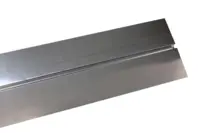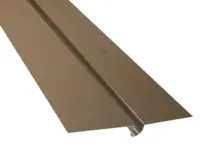- Forside
- Gode råd om gulv
- Gulvbelægninger
- Tekstile gulvbelægninger
- Akustikpaneler
- Afpassede tæpper
- Bambusgulve
- Bordplader & bordben
- Designgulve
- Fliser og klinker
- BeefEater gasgrill
- Gode råd om gulv
- Gulvtæpper
- Gulvvarme
- Græstæpper
- Korkgulve
- Køkken, bad & garderobe
- Laminatgulve
- Linoleumsgulve
- Maling, Væv & Spartel
- Måtter
- Møbler & Boliginteriør
- Nålefilt og messetæpper
- Plejeprodukter
- Restpartier & gode tilbud
- Sildebensparket & Stavparket
- Tæppefliser
- Terrassebrædder
- Tilbehør
- Trægulve
- Vareprøver
- Vinylgulv
- Værktøj
- Øvrige produkter
- Loft- og vægpaneler
- Flotte gulve
- Fyrretræsgulv
- Klikgulve
- Bestilte varer
-
-26%
-
Populær29,00 DKK
-
29,00 DKK pr m2
-
Populær21,00 DKK
-
29,00 DKK pr m2
Tekstile gulvbelægninger
Alle informationer på denne side er kopieret materiale fra Gulvfakta som er et fagteknisk opslagsmateriale, Kilde: Gulvfakta
Tekstiler er oprindelig en betegnelse for produkter, som er fremstillet ved en væve- eller tufteproces.
Du kan alternativt se vores indlæg om andre gulvbelægninger såsom laminatgulve, flisegulve eller trægulve.
1.2.0.1 Introduktion
1.2.0.2 CE-mærkning
1.2.0.3 Fremstilling af tekstile gulvbelægninger
1.2.0.4 Klassifikation
1.2.0.5 Krav til udførelsesstedet, prøvning og klassifikation
1.2.0.6 Forventninger til tekstile gulvbelægninger
Alle informationer på denne side er kopieret materiale fra Gulvfakta som er et fagteknisk opslagsmateriale, Kilde: Gulvfakta
1.2.0.1 Introduktion
Tekstiler er oprindelig en betegnelse for produkter, som er fremstillet ved en væve- eller tufteprocess. Tekstiler har en række gode egenskaber, der gør dem velegnede til gulvbelægninger. I daglig tale kaldes tekstile gulvbelægninger blot tæpper. De kan fremstilles af flere forskellige materiale-typer som fx uld og nylon og i forskellige konstruktioner.
Tekstile gulvbelægninger kan opdeles i følgende hovedkategorier iht. DS/EN 1307:
• Tæpper med luv (tuftede og vævede)
• Tæpper uden luv (fladvævede)
• Fladt nålefilt
• Nålefilt med luv
De fremstilles ved forskellige metoder. Metoderne tufting og vævning er de mest udbredte metoder. Ved at kombinere fremstillingsmetoder, bagsidetyper og tilsætningsmaterialer (hjælpematerialer) til garnerne kan man "skræddersy" tæpperne og fx gøre dem antistatiske og forbedre deres brandtekniske egenskaber.
Kapitlet indeholder:
• Indledning
• CE mærkning af tekstile gulvbelægninger
• Fremstilling af tekstile gulvbelægninger
• Valg af tæppetype
• Brugsklasser
• Farvers og mønstres betydning for tæppernes udseende
• Krav til udførelsesstedet
• Prøvning og klassifikation
• Oversigt over klassificerede, tekstile gulvbelægninger
• Appendiks - Grundlag for klassifikation
Afsnittet omhandler tekstile gulvbelægninger, som defineret i standarden ISO 2424. Klassifikationen af tekstile gulvbelægninger er baseret på DS/EN 1307.
Gulvbelægninger til private boliger falder uden for beskrivelserne i Gulvfakta. Derfor er det kun klassifikation af tæpper til kontraktmarkedet (erhverv), der omtales i det efterfølgende. I afsnittene kan du bl.a. læse om, hvilke overvejelser der bør foretages, før der træffes beslutning om at anvende tekstile gulvbelægninger. Senere i sektionen beskrives de tekniske krav, der skal dokumenteres for at få en belægning optaget som klassificeret tekstil gulvbelægning i Gulvbranchen.
1.2.0.2 CE-mærkning
Tekstile gulvbelægninger skal være CE-mærkede. Den harmoniserede standard DS/EN 14041, der ligger til grund for CE-mærkningen, gælder for produktion og anvendelse i Europa.
Det er producenten eller den forhandler, der markedsfører produktet, som er ansvarlig for CE-mærkningen.
De egenskaber der er omfattet af standarden fremgår af anneks ZA i DS/EN 14041:
• Reaktion ved brand
• Indhold af pentachlorophenol (PCP)
• Afgivelse af formaldehyd
• Vandtæthed
• Skridsikkerhed
• Antistatiske egenskaber
• Varmeledningsevne
• Holdbarhed af reaktion ved brand
CE-mærkning er ikke et kvalitetsmærke, men er en harmoniseret standard, der virker som gulvbelægningens rejsepas inden for det europæiske fællesskab.
CE-mærket kan være påtrykt rullens emballage eller en label klæbet på emballagen.
I figur 1 vises eksempler på, hvorledes CE-mærkerne kan udformes. I figur 2 ses eksempler på de piktogrammer, der kan indgå i mærkningen.
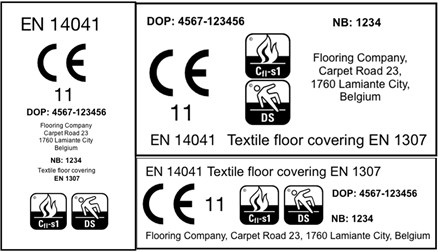 Fig. 1
Fig. 1
Figur 1. Eksempel på CE-mærkning af tekstile gulvbelægninger. Eksemplet gælder for tekstile gulvbelægninger under system 1 i henhold til standardens anneks ZA.

Figur 2. Eksempel på CE-mærkning som vil fremgå af det tekniske datablad for en tekstil gulvbelægning.
1.2.0.3 Fremstilling af tekstile gulvbelægninger
Tekstile gulvbelægninger fremstilles hovedsageligt ved enten tufting eller vævning, hvor tufting er den mest udbredte fremstillingsmetode. Ved fremstilling af tuftede tæpper sys garnet ned i et bærevæv ved hjælp af en tuftemaskine. For at forstærke luvgarnets forankring i bærevævet, forsynes tæpper med limforbestrygning, hvorpå der lægges en bagside, som typisk er latex, et syntetisk væv, filt, pvc eller bitumen.
Ved fremstilling af vævede tæpper sker processen ved, at luvgarnet sammenvæves med langsgående garner (kaldet kædegarner) og tværgarner (kaldet skudgarner). Garnet består af fibre, der kan være fremstillet af uld, polyamid (nylon), polyester, akryl eller polypropylen. Der anvendes også garner, hvor uld og polyamid blandes i forholdet 80/20.
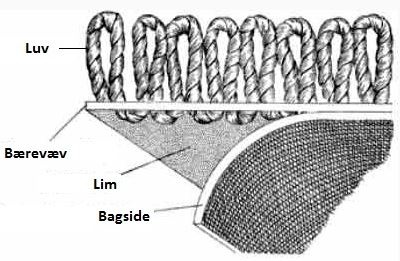 Fig. 3. Konstruktion af tuftet tæppe
Fig. 3. Konstruktion af tuftet tæppe
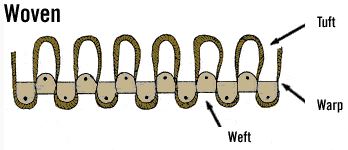
Teknisk information - generelt
Tekstile gulvbelægninger fås i forskellige varianter, som hver især findes i mange farver og mønstre. Tekstile gulvbelægninger produceres primært som banevarer, men findes også som tæppefliser. Mange oplever, at tekstile gulvbelægninger giver en god gangkomfort og at de har gode akustiske egenskaber (lyddæmpning). Herudover har de en overfladestruktur som gør, at støvpartikler opfanges og tilbageholdes. Egenskaberne afhænger af type/opbygning og anvendte materialer.
Valg af tekstile gulvbelægninger
Beslutning om hvilket tæppe, der skal anvendes i en konkret situation, bør ske på baggrund af en vurdering af tæppets egenskaber. Ved valg af tæppebelægninger, bør der mindst tages hensyn til:
• Trafikintensitet, særlig ved anvendelse af stole med hjul.
• Myndighedskrav til brandmæssige egenskaber.
• Elektrostatisk personopladning.
• Vedligehold.
• Farve og mønster.
1.2.0.4 Klassifikation
Til dokumentation af tæppers brugsegenskaber anvendes DS/EN 1307, som er en harmoniseret europæisk standard.
Standarden klassificerer tæpper i 3 klasser i forhold til trafikintensiteten:

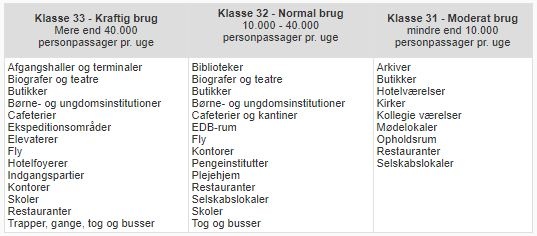
Ved valg af tæppebelægninger bør det overvejes om andre egenskaber, som ikke indgår i klassifikationen, har betydning og er afgørende for valg af tæppebelægningen. Følgende bør indgå i overvejelserne:
• Trinlyddæmpning.
• Akustisk dæmpning.
• Egnethed til brug i rum med følsomt elektronisk udstyr.
• Egnethed til områder, hvor der anvendes transportvogne.
• Varmetransmissionsmodstand.
• Egnethed til brug i rum med gulvvarme.
• Dampdiffussionsmodstand.
Ved projektering skal det påses, at kombinationen af undergulv, lim og tæppebelægning passer sammen.
Farvers og mønstres betydning for tæppernes udseende
Farver og mønstre har afgørende betydning for opfattelsen af tæppets udseende og rengøring, fx opleves tilsmudsning værre på et lyst, ensfarvet tæppe end på et mønstret tæppe med mørke farver.
1.2.0.5 Krav til udførelsesstedet, prøvning og klassifikation
Det er vigtigt, at tekstile gulvbelægninger og evt. lime akklimatiseres inden pålægning. Materialerne skal derfor anbringes i rummet minimum et døgn før arbejdets påbegyndelse. Skal tæppet fuldklæbes til undergulvet, skal temperaturen i luften og undergulvet være 17 - 25 °C og luftfugtigheden 30 - 75 % RF. Læs mere om kravspecifikationer for gulvlim.
Skal tæppet limes direkte på støbte dæk, må betonens porefugt (restbyggefugt) højst være på 90 % RF. Følg altid leverandørens anvisninger.
Læs mere om fugttekniske krav og fugtmåling.
Undergulvet skal have samme planhed, som kræves af det færdige gulv, normalt ± 2 mm på et 2 m retholt.
Der må ikke være kraftig træk eller kraftigt solindfald når tæppet lægges.
Forhold i forbindelse med lægning og brug
Tæppebaner skal altid ligge i samme retning i rummet og der skal anvendes baner fra samme produktionsbatch. Det er vigtigt, at banerne udlægges i rulle-numrenes rækkefølge inden for samme batch. Ved eventuel langsgående deling af en rulle er det vigtigt, at ægkant lægges mod ægkant for at undgå farve- og strukturforskel i samlingerne. Banerne lægges som hovedregel med samlingerne vinkelret på den mest lysgivende vinduesvæg.
For mønstrede tæpper er det vigtigt, at de kontrolleres for mønstertilpasning før lægning.
Samlinger skal udføres ved renskæring af kanter og med mønstertilpasning ved mønstrede tæpper. Leverandørens anvisninger om udførelse af til- og sammenskæringer skal følges. Samlinger bør så vidt muligt undgås på de mest udsatte steder, fx ved døråbninger, indgangspartier og under kontorstole med hjul. Samlinger bør ikke udføres på tværs af tæppets produktionsretning. Der må ikke placeres møbler, inventar m.m. på tæppet, før limen er hærdet. Ved tæppelægning på trapper bør der altid afsluttes med en trappeforkant.
Lægningsmetoder
Der findes mange forskellige metoder til tæppelægning. Det er derfor vigtig at overveje, hvilken metode der passer bedst til opgaven.
• Fuldfiksering - tæpper bliver fastholdt på hele gulvfalden.
• Vådlimning - tæppet bliver lagt i en våd dispersionslim udlagt med tandspartel.
• Sliplimning - tæpper bliver lagt i en våd dispersionslim udlagt med tandspartel på et slip-primet gulv.
• Vådfiksering - tæppet lægges i en våd fikseringslim udlagt med rulle. Bør kun anvendes på et spartlet undergulv.
• Hæftelimning/fiksering - tæppet monteres på fingertør hæftelim udlagt med rulle. Bør kun anvendes på et spartlet undergulv.
• Tørfiksering - tæppet bliver monteret på et fastklæbet underlag af fuldfladetape.
• Løslægning - tæppet er løst lagt men fastgjort med tape eller lim for enderne og/eller for siderne.
• På gribelister - tæppet er opstrammet på gribelister med et underlag af filt.
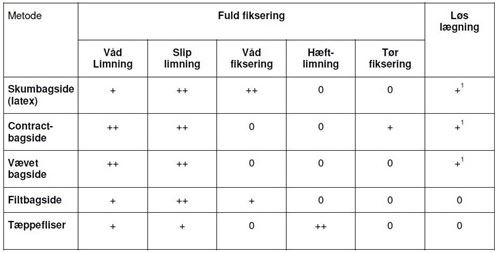
++: Anbefales
+: Kan anvendes
0: Er ikke mulig/aktuel
1) Belægninger større end 25 m² bør altid fuldfikseres.
Tæppelægning på gribelister fordrer en vævet bagside og anvendes kun sjældent i Danmark. Metoden omtales derfor ikke yderligere i Gulvfakta.
Afdækning
For at undgå skader på tæppet, bør det færdige gulv afdækkes med materialer, der beskytter mod den efterfølgende belastning, indtil ibrugtagning finder sted. Der bør kun bruges diffusionsåbne materialer og ikke tæt plast eller "mælkepap". Gangarealer og andre belastede eller udsatte områder bør afdækkes med hårde træfiberplader, som tapes i samlingerne.
Rengøring
De fremtidige brugere skal oplyses om korrekt rengøring, da forkert rengøring kan medføre skader på tæppet.
Til daglig rengøring anvendes støvsugning.
Leverandørens anvisninger om rengøring skal følges.
Klassifikation
Tæpper med luv er klassificeret i henhold til DS/EN 1307. De vigtigste egenskaber findes i tabel 3 - basiskrav, tabel 19 - funktionskrav og Annex A - Tæppefliser specifikke krav.
Ændring af udseende
Tæpperne prøves efter standarden ISO 10361.
En tæppeprøve anbringes på indersiden af en roterende tromle (Vettermann), hvor der simuleres en gangbelastning ved hjælp af en stålkugle. Prøvestykket vurderes efter kort- og langtidsprøvning. Prøveemnerne vurderes efter DS/EN ISO 9405.
Egnethed til brug med kontorstole med hjul
Tæpperne prøves efter DS/EN 985, som simulerer langtidspåvirkninger af en kontorstol med hjul. Tre hjul anbragt i en cirkel roterer om en akse i cirklens midte. Hjulene er belastet med 90 kg. Prøvestykket vurderes efter kort- og langtidsprøvning. Prøveemnerne vurderes efter DS/EN ISO 9405.
Kantfasthed
Tæpperne prøves efter DS/EN 1814. En tæppeprøve anbringes på indersiden af en roterende tromle (Vettermann), hvor der simuleres en gangbelastning ved hjælp af en stålkugle. Prøvestykkerne er forsynet med et skråt snit på langs således, at kanterne bliver påvirket af stålkuglen.
Tæppets samling vurderes efter Anneks D i DS/EN 1307.
Lysægthed
Ved prøvningen efter DS/EN ISO 105-B02 bestemmes farveændringen som følge af lyspåvirkning ved indendørs brug. Tæppeprøven belyses sammen med 8 referencestoffer.
Tæppeprøven bedømmes ved sammenligning med referencestof. Resultatet angives som en karakter mellem 1 og 8, hvor 8 er bedst.
Gnideægthed
Prøvning foretages efter DS/EN ISO 105-X12, hvor der bestemmes farveafsmitning på et hvidt bomuldsstykke i såvel tør, som våd tilstand. Afsmitningen bestemmes ved hjælp af en gråskala (DS/EN ISO 105-A03). Resultatet angives som en karakter mellem 1 og 5, hvor 5 er bedst.
Vandægthed
Prøvning foretages efter DS/EN ISO 105-E01, hvor farveændring og afsmitning som følge af vandpåvirkning bestemmes. Et stykke stof af multifibre lægges oven på tæppeprøven og "sandwichen" gennemvædes med vand og tørres efterfølgende. Efter tørring sammenlignes tæppeprøven med den oprindelige prøve og farveændringen bestemmes ved hjælp af en gråskala (DS/EN ISO 105-A02).
Ligeledes bestemmes afsmitning på multifiber ved hjælp af en gråskala (DS/EN ISO 105-A03).
Resultatet angives som en karakter mellem 1 og 5, hvor 5 er bedst.
Fiberfastholdelse
På tæpper med luv udføres prøvning af fiberfastholdelse efter DS/EN ISO 12951 med anvendelse af Lisson-maskinen, hvor et roterende hjul med påmonterede gummisåler udøver en slidpåvirkning på tæppet.
Ved løkketæpper vurderes loddenheden ved sammenligning med et referencefoto.
Ved tæpper med opskåren luv bestemmes massetabet.
Pilling
På tæpper uden luv udføres test af pillingtendens efter DS/EN ISO 12951 prøvning med anvendelse af Lisson-maskinen, hvor et roterende hjul med påmonterede gummisåler udøver en slidpåvirkning på tæppet.
Prøven sammenlignes med en referenceskala (fotoskala).
Dimensionsstabilitet
Banevarers dimensionsstabilitet prøves efter ISO 2551, mens tæppeflisers dimensionsstabilitet prøves efter DS/ EN 986.
Ved begge metoder udsættes tæppet for varierende forhold med hensyn til temperatur og fugt. Hvorefter dimensionsændringerne (under disse ekstreme forhold) bestemmes.
Elektrostatisk personopladning
Prøvning foretages efter ISO 6356, der fastlægger den elektrostatiske personopladning, når en person med standardiseret fodtøj går på en gulvbelægning.
Når prøvningsresultatet ved 25 % RF er mindre end 2 kV vil de færreste personer opleve stødgener.
Betegnelsen permanent antistatisk vil sige, at de elektrostatiske egenskaber er styret af ledende permanent antistatiske fibre.
Brandmæssige egenskaber
Prøvning af tæppers brandmæssige egenskaber foretages efter DS/EN ISO 9239-1 og klassificeres efter DS/EN 13501-1.
Tæpper, der benyttes i flugtveje og andre områder med krav til brand og røgudvikling, skal i Danmark have dokumentation for mindst at opfylde den europæiske brandklasse Dfl-s1 (klasse G gulvbelægning).
Dfl = klasse for flammespredning.s1 = klasse for røgudvikling.
1.2.0.6 Forventninger til tekstile gulvbelægninger
Vores oplevelse af et produkt er i meget høj grad styret af de forventninger vi har til det.
Gulvbranchen har udarbejdet en folder, der adresserer de forventninger du som forbruger med rette kan have til gulve med tekstile gulvbelægninger.
Læs eller download forventningsfolderen om tekstile gulvbelægninger.

